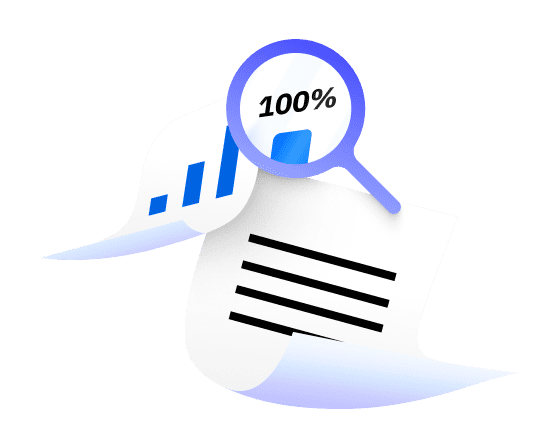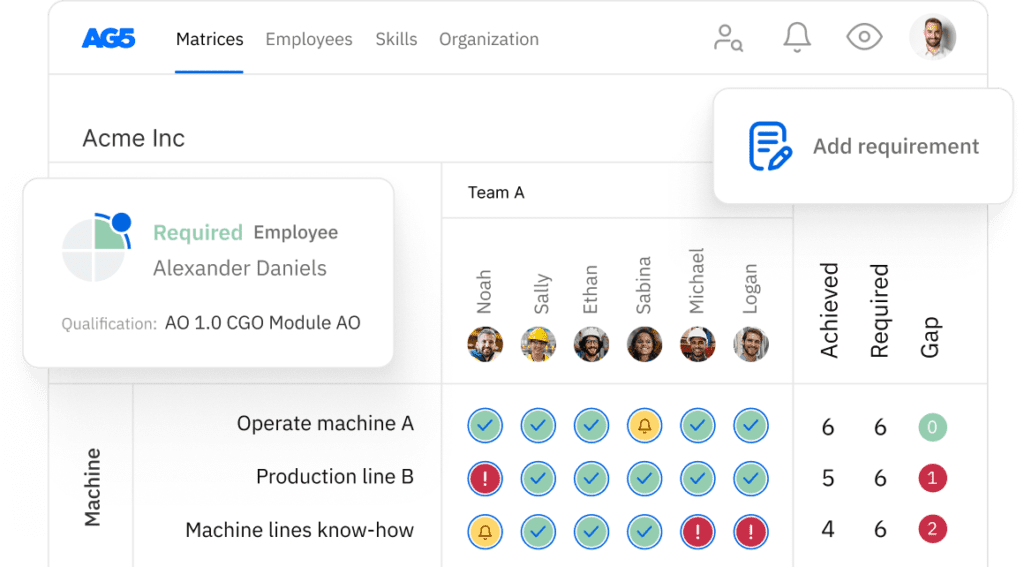10 tips for improving employee performance
During this article we talk about 10 effective strategies to boost employee performance. Discover actionable tips for maximizing team productivity and success.

High-performing, motivated, and satisfied employees are an important factor in your organization’s success. However, ensuring that you’re getting the most out of your workforce can be challenging – and when you consider that a lack of employee engagement is responsible for an approximately $1.9 trillion loss in productivity in the United States alone [1], it is even more important that you overcome it.
In this article, we’ll take a look at a few of the main reasons behind poor employee performance, as well as offer 10 tips that can help you boost it. We’ll also show how AG5’s skills management software can provide you with a foundation on which to build a workforce filled with high-performing employees.
Reasons for poor employee performanceCopied
Poor employee performance can be the result of several factors. Developing an understanding of them can help you address and improve these issues. In this section, we’ll look at a few of the main reasons for poor employee performance.
1. Lack of purpose
Employees generally perform better when they feel that their work has purpose [2]– and is focused on achieving clear objectives. It’s also a main driver of employee retention. This is why employees need to know why and how the tasks they are performing contribute to the organization.
2. Lack of high-quality feedback
Without constructive l feedback, employees will not know if, when, and how they must improve. Feedback can be either informal or formal, and offered both by managers and coworkers, so long as it is regularly and high-quality.
3. Lack of skills and knowledge
Employees can become demotivated and underperform without opportunities for professional development. In fact, a McKinsey study [3] found that up to 60% of an employee’s, knowledge, skills, and experience “can be attributed to skills acquired through work experience”. This means you must develop and implement a strategy that allows employees to focus on improving existing skills and developing new ones.
4. Lack of professional development
People who feel appreciated are generally more motivated and perform better. And don’t forget, even your best employees need a pat on the back every so often.
How to improve employee performanceCopied
You can take many steps to avoid the pitfalls we’ve laid out above that can contribute to poor employee performance. In this section, we’ll offer 10 tips you can use to foster a workplace culture that is productive, efficient, and high-performing.
1. Identify the problem
If an employee is underperforming, you must first clearly identify the source of the problem. Is there a lack of communication? Does the role match the employees’ skills? Are they getting clear, consistent feedback? Make sure you approach the situation with all the knowledge you’ll need to improve it.
2. Set clear expectations
What results, targets, and deadlines are expected of your employees, teams, and departments? How do they contribute towards your organization’s objectives? Clearly communicate the answers to both of these questions to all of your employees, as they wi [7]ll allow you to better manage performance.
3. Invest in training and professional development
Training and professional development is an ongoing process, and as such should be considered an investment. Rather than one-off onboarding, develop training and development plans for your employees that are involved, personal, and, most importantly, continuous.
4. Improve onboarding
The importance of proper onboarding for new employees is often grossly underestimated. Effective onboarding ensures that staff become productive and adapt to their new job or role more quickly. [4]
5. Improve workplace culture
Studies show that happy employees are better performers [5]. A workplace where people are actively involved in the decision-making processes and whose voices are heard helps drive employee happiness – and in turn boost productivity and performance.
6. Use the right tools
Implementing the right collaboration and communication tools can significantly enhance employee performance, raising productivity by as much as 25% [6]. Whether it’s skills management software or simple chat applications like Microsoft Teams, employees and teams who are able to easily and efficiently stay in contact yield better results.
7. Eliminate micromanagement
Effective managers function as coaches, and make decisions through close consultation with their team members. They excel in delegation while remaining accessible for advice and guidance. On the other hand, micromanaging leaders can inhibit employee creativity and proactivity – and therefore performance.
8. Build better teams
Take steps to build effective teams, led by strong leaders and comprised of members who work well together, are able to set clear (and shared) goals, provide mutual feedback, and hold each other accountable for results – all of which are strong indicators of high performance. [7]
9. Improve interdepartmental (or intersite) communication
Over time – and without action from leadership – different sites or departments may become isolated and siloed. This hampers communication, and eventually employee performance. Ensuring that your sites and departments are aligned and communicative goes a long way toward employees who are collaborative, working toward the same goals, and high-achieving.
10. Celebrate successes
Recognizing and celebrating employee achievements and milestones is crucial for maintaining high motivation levels – and motivated employees are 81% more likely to show up to work and 14% more productive [8]. Recognition programs – which often take the form of bonuses, gifts, or after-work events – boost morale and encourage employees to strive for higher performance.
How often should you conduct an employee performance evaluation?Copied
For the most effective performance management, you should conduct performance reviews regularly [9]. By supplementing (or replacing) formal annual reviews with an approach that hinges on continuous feedback, you’ll emphasize the importance of coaching and developing rather than ratings and rankings.
This shift can help employees receive timely, actionable insights, which leads to ongoing improvement, improved alignment with organizational goals, better performance.
Improve employee performance with AG5Copied
AG5 provides you with an easy-to-use platform you can use to improve employee performance. Your sites, departments, teams, and employees can use the software to stay aligned, continuously improve, develop recruitment and upskilling initiatives, drive employee engagement, and more.
You can also use AG5 to:
- Map the skills, knowledge, and competences present in your organization – as well as those your employees need
- Replicate complex organizational structures with drag-and-drop menus
- Find the best replacements for employees off sick in a single search
- Enter updates and training results from the shop floor in real time
- Match projects to specific employees’ expertise and experience
Want to see how it works? Schedule a free, live, 15-minute demo for a customized look at what AG5 can do for your organization.
Sources Copied
- Change view: Table
-
APA
| # | Source title | Description | Publication | Retrieved | Source URL |
|---|---|---|---|---|---|
| 1 | In New Workplace, U.S. Employee Engagement Stagnates | Gallup | August 1, 2024 | August 1, 2024 | https://www.gallup.com/workpla.. |
| 2 | Help your employees find purpose—or watch them leave | McKinsey | August 1, 2024 | August 1, 2024 | https://www.mckinsey.com/capab.. |
| 3 | Reimagining people development to overcome talent challenges | McKinsey | August 1, 2024 | August 1, 2024 | https://www.mckinsey.com/capab.. |
| 4 | Transforming the new hire onboarding experience | Deloitte | August 1, 2024 | August 1, 2024 | https://www2.deloitte.com/us/e.. |
| 5 | Happy workers are 13% more productive | Oxford | August 1, 2024 | August 1, 2024 | https://www.ox.ac.uk/news/2019.. |
| 6 | The social economy: Unlocking value and productivity through social technologies | McKinsey Global Institute | August 1, 2024 | August 1, 2024 | https://www.mckinsey.com/indus.. |
| 7 | Goal Setting in Teams: Goal Clarity and Team Performance in the Public Sector | National Library of Medicine | August 1, 2024 | August 1, 2024 | https://www.ncbi.nlm.nih.gov/p.. |
| 8 | Employee Engagement vs. Employee Satisfaction and Organizational Culture | Gallup | August 1, 2024 | August 1, 2024 | https://www.gallup.com/workpla.. |
| 9 | In the spotlight: Performance management that puts people first | McKinsey | August 1, 2024 | August 1, 2024 | https://www.mckinsey.com/capab.. |
Author Copied
Revisions Copied
Rewrote existing content, added “How often should you conduct an employee performance evaluation?” section, added sources
Written by: Gea Vermast
Technically reviewed by: Adam

